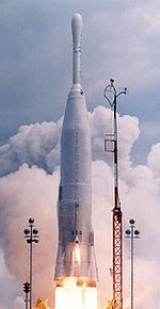
Atlas-Able
Encyclopedia
The Atlas-Able was an American
expendable launch system
derived from the SM-65 Atlas missile. It was a member of the Atlas
family of rockets, and was used to launch several Pioneer
spacecraft towards the Moon
. Of the five Atlas-Able rockets built, two failed during static firings, and the other three failed to reach orbit.
The Atlas-Able was a three and a half stage rocket, with a stage and a half Atlas missile as the first stage, an Able second stage, and an Altair
third stage. The first Atlas-Able used an Atlas C
as the first stage, but this exploded during a static fire test. The remaining launches used Atlas D
missiles. Launches were conducted from Launch Complexes 12
and 14
at the Cape Canaveral Air Force Station
. One launch was planned from Launch Complex 13
, however this became the second Atlas-Able to be destroyed during a static firing, and hence never launched.
United States
The United States of America is a federal constitutional republic comprising fifty states and a federal district...
expendable launch system
Expendable launch system
An expendable launch system is a launch system that uses an expendable launch vehicle to carry a payload into space. The vehicles used in expendable launch systems are designed to be used only once , and their components are not recovered for re-use after launch...
derived from the SM-65 Atlas missile. It was a member of the Atlas
Atlas (rocket family)
Atlas is a family of U.S. space launch vehicles. The original Atlas missile was designed in the late 1950s and produced by the Convair Division of General Dynamics, to be used as an intercontinental ballistic missile...
family of rockets, and was used to launch several Pioneer
Pioneer program
The Pioneer program is a series of United States unmanned space missions that was designed for planetary exploration. There were a number of such missions in the program, but the most notable were Pioneer 10 and Pioneer 11, which explored the outer planets and left the solar system...
spacecraft towards the Moon
Moon
The Moon is Earth's only known natural satellite,There are a number of near-Earth asteroids including 3753 Cruithne that are co-orbital with Earth: their orbits bring them close to Earth for periods of time but then alter in the long term . These are quasi-satellites and not true moons. For more...
. Of the five Atlas-Able rockets built, two failed during static firings, and the other three failed to reach orbit.
The Atlas-Able was a three and a half stage rocket, with a stage and a half Atlas missile as the first stage, an Able second stage, and an Altair
Altair (rocket stage)
The Altair was a solid-fuel rocket with a fiberglass casing, initially developed for use as the third stage of Vanguard rockets. It was manufactured by Allegany Ballistics Laboratory as the X-248. It was also sometimes called the Burner 1.-Uses:...
third stage. The first Atlas-Able used an Atlas C
SM-65C Atlas
The SM-65C Atlas, or Atlas C was a prototype of the Atlas missile. First flown on 24 December 1958, the Atlas C was the final development version of the Atlas rocket, prior to the operational Atlas D...
as the first stage, but this exploded during a static fire test. The remaining launches used Atlas D
SM-65D Atlas
The SM-65D Atlas, or Atlas D, was the first operational version of the U.S. Atlas missile. It first flew on April 14, 1959. Atlas D missiles were also used for orbital launches, both with upper stages and on their own as a stage-and-a-half vehicle....
missiles. Launches were conducted from Launch Complexes 12
Cape Canaveral Air Force Station Launch Complex 12
Launch Complex 12 at Cape Canaveral Air Force Station, Florida is a launch pad used by Atlas rockets and missiles between 1958 and 1967. It is the second-most southern of the pads known as missile row, between LC-11 to the south and LC-13 to the north...
and 14
Cape Canaveral Air Force Station Launch Complex 14
Launch Complex 14 is a launch site at Cape Canaveral Air Force Station, Florida. LC-14 was used for various manned and unmanned Atlas launches, including the Friendship 7 flight aboard which John Glenn became the first American to orbit the Earth....
at the Cape Canaveral Air Force Station
Cape Canaveral Air Force Station
Cape Canaveral Air Force Station is an installation of the United States Air Force Space Command's 45th Space Wing, headquartered at nearby Patrick Air Force Base. Located on Cape Canaveral in the state of Florida, CCAFS is the primary launch head of America's Eastern Range with four launch pads...
. One launch was planned from Launch Complex 13
Cape Canaveral Air Force Station Launch Complex 13
Launch Complex 13 at Cape Canaveral Air Force Station, Florida is a deactivated launch complex used by Atlas rockets and missiles between 1958 and 1978. It is the third-most southern of the complexes known as missile row, between LC-12 and LC-14...
, however this became the second Atlas-Able to be destroyed during a static firing, and hence never launched.

